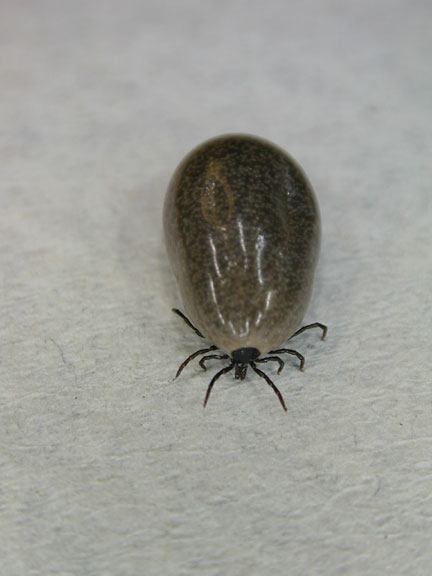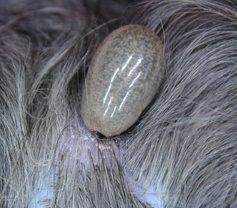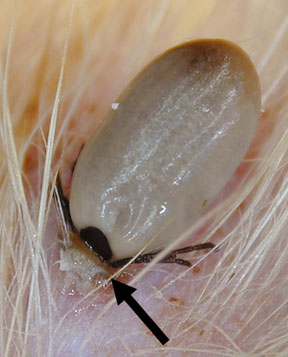|
For an overview of why we want to get these pests out, go to the Tick talk page.
We are somewhat lucky in that none of the ticks we tend to see locally are big biters. Oh, they attach well and will stay attached to a host for a long time, but they don't shove their mouthparts in to the point that their heads are buried. Some of the ticks commonly seen in the southern USA attach deep and are pretty hard to get out.

Here (left) is a picture of a small tick right after we removed it from a dog. It is a little fat because it had fed for a while, probably a day or two. It's a good picture of the basic tick body parts - there are 8 legs, a small plate of dark grey armor where the thorax is, and the mouthparts in the front. The grey body is where the stomach is and where the blood collects, engorging the tick's body.

On the front of this tick (grey tick on a grey dog, right) you can't really see the mouthparts - they are buried in the skin. The legs are still right at the front by the head but are very hard to see, and the body has expanded enormously behind like a big balloon. This guy had probably been attached for several days, plenty of time to start transmitting Lyme disease if he carried it.

And here's a another tick at the trough. See how far forward the legs are? He has his face buried in the dog's skin with the mouthparts sunk in, sucking up blood. Notice that there is some guck collecting around where he is feeding. This is some dead tissue and some inflammatory exudate caused by his feeding.
So ... we need to get him outta there! Here's how.
Note: This method is not very masculine. It involves no power tools or flames. No Vaseline, gasoline, or other combustible materials. No animals or people should be harmed in the performance of this segment.
1. Make sure the thing you are trying to remove really is a tick.
Get the dog to hold still and part the hair. Move the thing to one side with your finger and see if you can see legs where it attaches. Make sure it's the right color. Ticks tend to look like the one of the two different ticks on this page - usually a grey color or tan/brown.
If you have any doubts as to what it is, see a vet. If you can't get it off, see a vet. If it starts to bleed, see a vet. If your dog bites you, see a doctor, and send someone else with the dog to a vet. I have had clients try to remove warts, skin tags, cysts, nipples (!) and small skin tumors thinking they were ticks. Needless to say, their dogs were not happy.
2. Congratulations, it's a tick! You will need:
- a) a pair of pointy tweezers, OR b) a cool tick removal hook (right), OR c) really long fingernails and a non-squeamish personality
- ziplock bag
- moistened cotton or piece of paper towel
- Polysporin or other over the counter general purpose antibiotic cream
3. Part the hair and get a good look at the tick. Figure out where it is attached to the animal.
Important note before we go any further: Do not hang onto the tick by the body; you will make it regurgitate into your dog. You could also burst the tick, which is just gross and not particularly helpful to the situation, though somewhat dramatic and cool if there are teenagers around. Don't squeeze the tick at all if you can help it.
4. Slide the claw of the tick remover under the tick. The concept is just like using the claw of a hammer to remove a nail from a piece of wood. Get the remover claw snugged right up under the tick, so the tick is up in the slot as far as possible. If you are using tweezers, squeeze them almost closed and put the tips under the tick between the head and the skin. If you want to use your fingernails, be my guest. Same concept.
5. Using steady, firm pressure pull the tick straight up and away from the animal. You may want to hold the skin down on either side, as it will tend to tent up and rise with the tick. These little guys are really stuck in there, so you can't be too wimpy. You don't want to break the tick by pulling too hard, but you don't want to have to take 52 tries to get it out, either; your dog will not love you anymore. There may be a tearing sensation as it lets go; this is fine and won't hurt the dog.
6. Do not fling the tick across the room in disgust. It is still alive and could theoretically reattach to the dog, the cat, or your visiting mother-in-law. Instead, calmly take the tick and place it in your pre-prepared ziplock bag. Make sure there is some air in the bag with the tick. Put the moistened cotton in the bag as well. Make sure the cotton isn't soaking wet; squeeze it out so no water drips off. It will provide something for the tick to drink while you have it in captivity.
7. Place the tick-in-a-bag in the refrigerator. Keep it there until you can get it to your veterinarian and have it sent off for Borrelia testing. The tick will live quite happily in the fridge for a few weeks if need be. I am not sure why you might want to do this, though. Just bring it in to us.
8. You may disinfect the site with a little soap and warm water. Rinse well. If you want to apply alcohol to the site: don't! It will really hurt! Peroxide won't sting as much but isn't particularly effective. Soap and water will do the trick.
9. Find the spot on the dog where the tick was attached and apply a little Polysporin. Ticks set up a pretty big inflammatory response. It is normal to see a ring of pink or red where it was attached, and a scab. The dog will usually lose hair around the area as well. This is normal as long as there is no discomfort and you are not seeing a lot of pus in the area.
We sometimes refer to this as a "tick granuloma". This localized swelling and thickening can take several weeks to resolve. As long as there is no pus and things seem to be getting gradually better rather than worse, things are fine.
If your dog seems itchy at the site, go ahead and apply a little Caladryl ointment or whatever non-stinging stuff you usually use for mosquito bites on yourself. Be a little cautious that he doesn't lick it off.
10. If you can stand it, check out the tick. If it is alive and waving its legs, you removed the whole thing and didn't leave mouthparts or head behind. If it is dead and not waving, your dog is still going to be OK. The remaining mouthparts will not:
- burrow into the brain
- cause seizures
- cause distemper
- cause rabies
- increase the risk of Borrelia transmission
They will fester a little and might form a localized infection. Watch for this; it might be worth a visit to the vet.
|